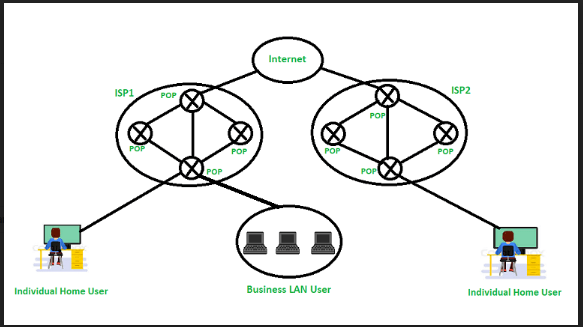What Does Pop Stand for in Computers
POP Full Form
POP stands for Point of Presence (also known as Post Office Protocol).
It is a point where many devices share a connection and can communicate with each other. We can say that it is a man-made demarcation point (a point where the public network of a company ends and the private network of the customer begins for eg. the point at which your broadband cable enters the house) between communicating entities. It basically consists of high-speed telecommunications equipment and technologies helps in bringing together people from all over the internet.
Attention reader! Don't stop learning now. Practice GATE exam well before the actual exam with the subject-wise and overall quizzes available in GATE Test Series Course.
Learn all GATE CS concepts with Free Live Classes on our youtube channel.

An example of this would be the local access point that connects customers via their internet service provider (ISP) to the rest of the world. The size of an ISP can be calculated by seeing the number of POPs that the service provider has. The normal houses routers, modems, servers, switches, and other such devices that have to share data over networks all use POPs. Internet Service Providers have multiple POPs.
Characteristics of POP :
- Post Office Protocol is an open protocol, defined by Internet RFCs.
- It allows access to new mail from a spread of client platform types.
- It supports download and delete functions even when offline.
- It requires no mail gateways due to its native nature.
- POP can handle email access only while the emails are sent by SMTP.
RFC 918 got published in 1984 which defined the Post Office Protocol (POP). The explanation of why POP came in the picture was to supply a neater way for a client computer to retrieve e-mail on an SMTP (Simple Mail Transfer Protocol) server so that it can be used locally. POP Version 2 got published in 1985.
It improvised the capabilities of POP by defining a far impressive set of commands further as replies. RFC 1939 was published in 1996 and POP3 has not been improvised since that point.
Examples:
- Carrier hotels :
These buildings are extremely secure with size averaging around 54, 000 square feet. These hotels offer hardware and software installation, updation and several other services. - Meet-me rooms :
Meet-Me Rooms (MMRs) are small space inside carrier hotels, averaging around 5, 000 square feet. These small rooms house interconnects networking equipment owned by many telecommunication companies.

Figure – Post Office Protocol (POP)
Working:
POP's working is based on its five important equipment which are:
- Base stations – A central point of reference to an access point and bandwidth management to ensure evenly distribution of the connection speed of the customer.
- Client equipment – utilized by customers to link with the base stations
- Network switches – Used for proper distribution
- Routers – Provides multiple paths for the data to be shared in the network
- Firewall – Used for securing the network from threats (internal and external)
Advantages:
The latest version of Post Office Protocol (POP3) is that the most widely used protocol and is being supported by most of the email clients.
It provides a convenient and standard way for users to access mailboxes and download messages. An important advantage of this is that the mail messages get delivered to the client PC and they can be read with or without accessing the web.
More advantages are:
- Creation of latest messages impossible without being logged onto the web
- All messages get stored on the disc drive of your computer
- Easy to use and configure.
- As the attachments are already on your PC, opening them may be a quicker process
- There isn't any maximum size on your mailbox, except as determined by the scale of your disc drive
Disadvantages:
- Consumes large memory as all the messages are stored on the disc drive
- Opening attachments may be a fast process unless the attachment contains a virus
- Since all attachments get downloaded on your computer, there's a danger of virus attack if they're not
scanned by antivirus softwares as these scans are only 60% effective - Emails cannot be opened by other machines unless they are configured to do so.
- Email folders can become corrupted and might even drift.
- It is not easy to export a local mail folder to another physical machine or another mail client.
What Does Pop Stand for in Computers
Source: https://www.geeksforgeeks.org/pop-full-form/#:~:text=POP%20stands%20for%20Point%20of,can%20communicate%20with%20each%20other.
0 Response to "What Does Pop Stand for in Computers"
Post a Comment